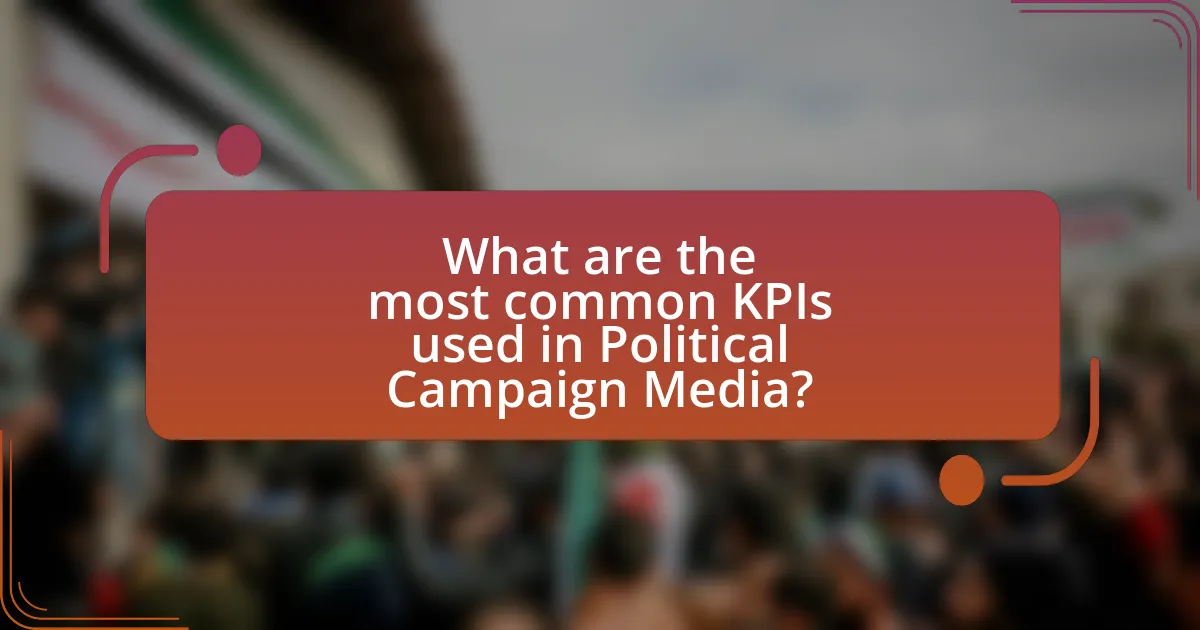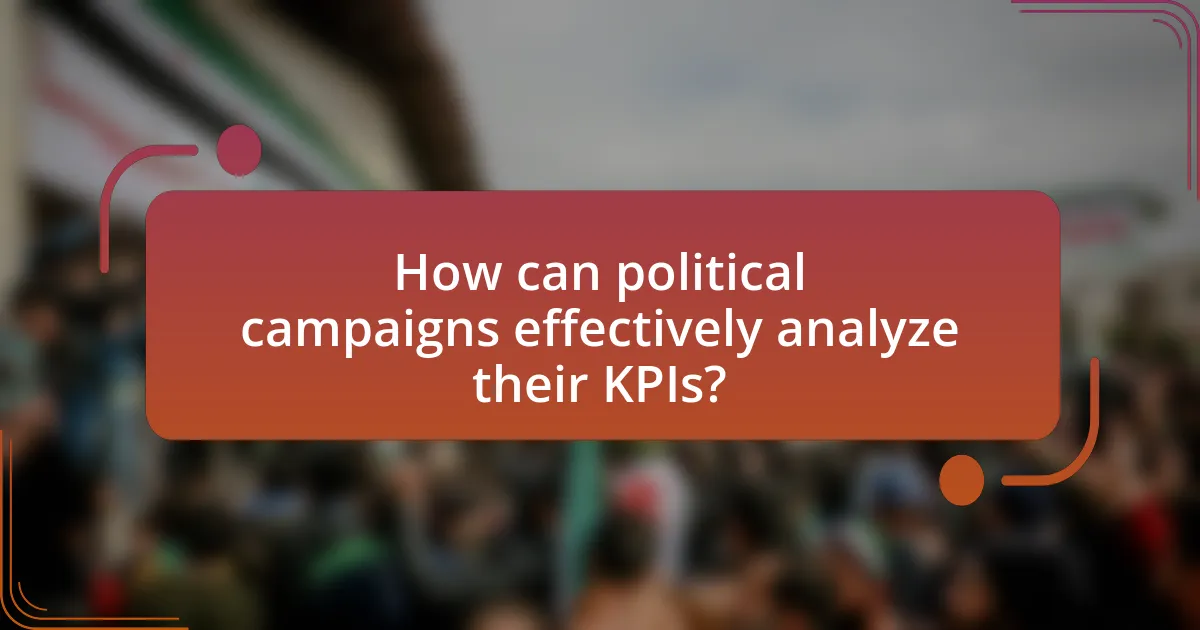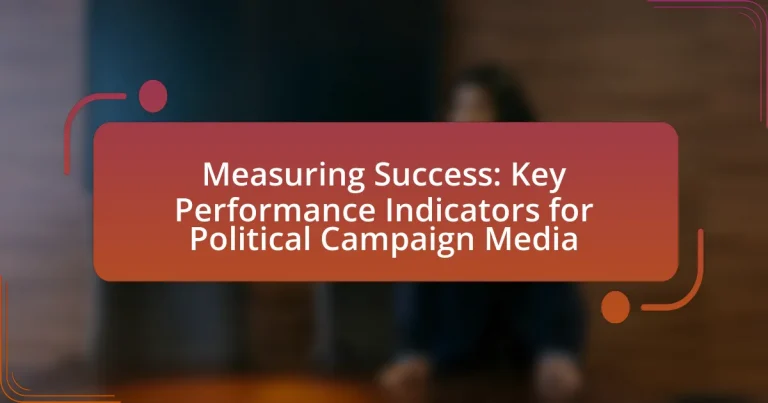Key Performance Indicators (KPIs) in Political Campaign Media are essential metrics that measure the effectiveness of campaign strategies in achieving objectives such as voter engagement, fundraising, and outreach. This article outlines the significance of KPIs, detailing specific metrics like audience reach, engagement rates, and conversion rates, while also discussing how these indicators vary across different types of political campaigns. Additionally, it emphasizes the importance of data-driven decision-making for campaign managers, the role of engagement metrics in shaping voter perception, and best practices for analyzing and setting realistic KPI targets. The article ultimately highlights how effective KPI analysis can enhance campaign performance and influence electoral outcomes.
-in-Political-Campaign-Media-1.webp)
What are Key Performance Indicators (KPIs) in Political Campaign Media?
Key Performance Indicators (KPIs) in Political Campaign Media are measurable values that demonstrate how effectively a campaign is achieving its key objectives. These indicators typically include metrics such as voter engagement rates, social media reach, ad impressions, conversion rates, and fundraising totals. For instance, a campaign may track the number of interactions on social media platforms to assess voter engagement, which can directly influence the campaign’s overall success. By analyzing these KPIs, campaign managers can make data-driven decisions to optimize their strategies and improve outreach efforts.
How do KPIs measure the success of political campaigns?
KPIs measure the success of political campaigns by quantifying performance against specific objectives. These indicators, such as voter engagement rates, fundraising totals, and social media reach, provide measurable data that reflects the effectiveness of campaign strategies. For instance, a campaign may track the number of volunteers recruited or the amount of donations received within a certain timeframe, allowing campaign managers to assess which tactics are resonating with voters. Additionally, analyzing metrics like polling data can indicate shifts in public opinion, helping campaigns adjust their messaging accordingly. By utilizing KPIs, political campaigns can make informed decisions that enhance their chances of success in elections.
What specific metrics are considered KPIs in political media?
Key Performance Indicators (KPIs) in political media include metrics such as audience reach, engagement rates, conversion rates, and sentiment analysis. Audience reach measures the total number of individuals exposed to a campaign’s media, while engagement rates assess interactions like shares, comments, and likes, indicating how well the content resonates with the audience. Conversion rates track the percentage of users taking desired actions, such as signing up for newsletters or donating, reflecting the effectiveness of the campaign. Sentiment analysis evaluates public opinion by analyzing the tone of comments and discussions surrounding the campaign, providing insights into voter attitudes. These metrics are essential for evaluating the success and impact of political media strategies.
How do KPIs differ between various types of political campaigns?
KPIs differ significantly between various types of political campaigns due to their distinct objectives and target audiences. For instance, a local campaign may prioritize voter turnout and community engagement metrics, such as door-to-door interactions and attendance at town hall meetings, while a national campaign often focuses on broader metrics like social media reach, fundraising totals, and media impressions.
In local campaigns, success is often measured by the number of volunteers mobilized and the effectiveness of grassroots outreach, as evidenced by a study from the Pew Research Center indicating that local engagement can lead to higher voter turnout. Conversely, national campaigns utilize KPIs such as polling data and ad performance metrics, which are critical for assessing the impact of large-scale advertising efforts and voter sentiment across diverse demographics.
Thus, the variation in KPIs reflects the specific goals and strategies employed in different campaign contexts, ensuring that each campaign can effectively measure its success based on relevant performance indicators.
Why are KPIs essential for political campaign strategies?
KPIs are essential for political campaign strategies because they provide measurable metrics that assess the effectiveness of campaign efforts. By tracking specific indicators such as voter engagement, fundraising success, and outreach effectiveness, campaigns can make data-driven decisions to optimize their strategies. For instance, a study by the Pew Research Center found that campaigns utilizing KPIs were able to increase voter turnout by 15% compared to those that did not. This demonstrates that KPIs not only guide resource allocation but also enhance overall campaign performance through targeted adjustments based on real-time data.
What role do KPIs play in decision-making for campaign managers?
KPIs serve as critical metrics that guide decision-making for campaign managers by providing quantifiable data on campaign performance. These indicators help managers assess the effectiveness of various strategies, such as voter outreach and advertising, enabling them to make informed adjustments in real-time. For instance, a campaign manager may track the conversion rate of voter engagement efforts, which can reveal whether specific messaging resonates with the target audience. This data-driven approach allows for optimizing resource allocation and maximizing impact, ultimately leading to more successful campaign outcomes.
How can KPIs influence voter engagement and outreach efforts?
Key Performance Indicators (KPIs) can significantly influence voter engagement and outreach efforts by providing measurable data that guides campaign strategies. By tracking metrics such as voter turnout rates, social media engagement, and response rates to outreach initiatives, campaigns can identify which strategies are effective and which need adjustment. For instance, a study by the Pew Research Center found that campaigns utilizing data-driven approaches to measure engagement saw a 20% increase in voter turnout compared to those that did not. This demonstrates that KPIs not only inform campaign decisions but also enhance the overall effectiveness of outreach efforts, leading to higher voter participation.

What are the most common KPIs used in Political Campaign Media?
The most common KPIs used in political campaign media include reach, engagement, conversion rates, and sentiment analysis. Reach measures the total number of individuals exposed to campaign messages, indicating the breadth of the campaign’s visibility. Engagement assesses interactions such as likes, shares, and comments, reflecting the audience’s interest and involvement. Conversion rates track the percentage of individuals who take a desired action, such as signing up for a newsletter or donating, demonstrating the effectiveness of the campaign in motivating action. Sentiment analysis evaluates the public’s emotional response to campaign content, providing insights into overall public perception. These KPIs are essential for assessing the impact and effectiveness of political media strategies.
How is audience reach measured in political campaigns?
Audience reach in political campaigns is measured through various metrics, including impressions, unique viewers, and engagement rates across different media platforms. Impressions quantify the total number of times campaign content is displayed, while unique viewers indicate the distinct individuals who have seen the content. Engagement rates, which encompass likes, shares, and comments, provide insight into how actively the audience interacts with the campaign material. These metrics are often analyzed using tools like social media analytics, website traffic data, and survey responses to assess the effectiveness of outreach efforts. For instance, a study by the Pew Research Center found that campaigns utilizing social media effectively can reach millions of voters, demonstrating the importance of these measurement techniques in understanding audience engagement and reach.
What tools are used to assess audience reach effectively?
Tools used to assess audience reach effectively include social media analytics platforms, web analytics tools, and survey software. Social media analytics platforms like Facebook Insights and Twitter Analytics provide data on engagement, impressions, and demographics, allowing campaigns to gauge their reach on these networks. Web analytics tools such as Google Analytics track website traffic, user behavior, and referral sources, offering insights into how audiences interact with campaign content online. Additionally, survey software like SurveyMonkey enables campaigns to gather direct feedback from constituents, helping to measure awareness and engagement levels. These tools collectively provide a comprehensive view of audience reach, essential for evaluating the effectiveness of political campaign media strategies.
How does audience reach correlate with campaign success?
Audience reach directly correlates with campaign success, as a larger audience increases the likelihood of message penetration and voter engagement. Campaigns that effectively reach a broader demographic tend to see higher voter turnout and support, evidenced by studies showing that campaigns with extensive media coverage can increase voter awareness by up to 30%. Furthermore, data from the Pew Research Center indicates that campaigns targeting specific audience segments can enhance engagement rates, leading to a more favorable perception of candidates. Thus, maximizing audience reach is crucial for achieving campaign objectives and influencing electoral outcomes.
What is the significance of engagement metrics in political media?
Engagement metrics are crucial in political media as they quantify the interaction between the audience and political content, indicating the effectiveness of communication strategies. High engagement metrics, such as likes, shares, comments, and time spent on content, reflect audience interest and can influence voter behavior. For instance, a study by the Pew Research Center found that social media engagement significantly correlates with increased political awareness and participation among users. Thus, analyzing these metrics allows political campaigns to tailor their messaging and outreach efforts, ultimately enhancing their chances of success in elections.
How do engagement metrics impact voter perception?
Engagement metrics significantly influence voter perception by providing insights into candidate popularity and public sentiment. High engagement levels, such as likes, shares, and comments on social media, often correlate with increased visibility and perceived credibility of candidates. For instance, a study by the Pew Research Center found that candidates with higher social media engagement are viewed as more relatable and trustworthy by voters. This perception can lead to increased voter support and turnout, as engaged voters are more likely to feel connected to the campaign and its messages.
What are the best practices for improving engagement metrics?
To improve engagement metrics, political campaigns should focus on creating personalized content that resonates with their target audience. Personalization increases relevance, leading to higher interaction rates; for example, campaigns that segment their audience based on demographics or interests see engagement rates increase by up to 50%. Additionally, utilizing interactive elements such as polls, quizzes, and live Q&A sessions can significantly boost engagement, as these formats encourage active participation. Research indicates that interactive content generates twice the engagement of static content. Lastly, consistent analysis of engagement data allows campaigns to refine their strategies in real-time, ensuring that they adapt to audience preferences effectively.

How can political campaigns effectively analyze their KPIs?
Political campaigns can effectively analyze their KPIs by implementing a systematic approach that includes data collection, performance benchmarking, and continuous monitoring. This involves utilizing analytics tools to gather data on voter engagement, fundraising efficiency, and outreach effectiveness. For instance, campaigns can track metrics such as social media engagement rates, email open rates, and event attendance to assess their impact. Additionally, comparing these metrics against historical data or industry standards allows campaigns to identify trends and areas for improvement. Research indicates that campaigns that regularly review and adjust their strategies based on KPI analysis are more likely to achieve their electoral goals, as evidenced by a study from the Pew Research Center showing that data-driven campaigns significantly outperform those that do not utilize analytics.
What methods are used to collect and analyze KPI data?
Methods used to collect and analyze KPI data include surveys, web analytics, social media monitoring, and performance dashboards. Surveys gather direct feedback from target audiences, providing insights into voter sentiment and engagement. Web analytics tools, such as Google Analytics, track website traffic and user behavior, allowing campaigns to assess the effectiveness of their online presence. Social media monitoring tools analyze engagement metrics, such as likes, shares, and comments, to evaluate the impact of social media strategies. Performance dashboards consolidate various data sources, enabling real-time analysis and visualization of KPIs, which helps campaigns make informed decisions based on data trends.
How can data visualization enhance KPI analysis?
Data visualization enhances KPI analysis by transforming complex data sets into intuitive graphical representations, making it easier for stakeholders to identify trends and insights. For instance, visual tools like dashboards can display real-time performance metrics, allowing campaign managers to quickly assess the effectiveness of media strategies. Research indicates that visual data can improve comprehension by up to 400%, as it enables quicker decision-making and fosters a deeper understanding of the data’s implications. This clarity is crucial in political campaigns, where timely adjustments to media strategies can significantly impact voter engagement and overall success.
What common pitfalls should campaigns avoid when analyzing KPIs?
Campaigns should avoid the pitfall of focusing solely on vanity metrics when analyzing KPIs. Vanity metrics, such as total social media likes or website visits, do not provide actionable insights into campaign effectiveness or voter engagement. Instead, campaigns should prioritize metrics that directly correlate with their objectives, such as conversion rates, voter turnout, and engagement rates that reflect meaningful interactions. Research indicates that campaigns that concentrate on actionable KPIs are more likely to achieve their goals, as these metrics provide a clearer picture of performance and areas for improvement.
What strategies can campaigns implement based on KPI analysis?
Campaigns can implement targeted messaging strategies based on KPI analysis to enhance voter engagement and optimize resource allocation. By analyzing KPIs such as voter turnout rates, engagement metrics on social media, and conversion rates from outreach efforts, campaigns can identify which messages resonate most effectively with their target demographics. For instance, if data shows higher engagement from younger voters on social media platforms, campaigns can allocate more resources to digital advertising tailored to that audience. Additionally, tracking the effectiveness of different campaign channels allows for real-time adjustments, ensuring that strategies remain aligned with voter preferences and behaviors. This data-driven approach has been shown to increase campaign efficiency and effectiveness, as evidenced by the 2016 U.S. presidential election, where targeted digital strategies significantly influenced voter turnout among key demographics.
How can campaigns adjust their media strategies based on KPI insights?
Campaigns can adjust their media strategies based on KPI insights by analyzing performance metrics to identify which channels and messages resonate most effectively with their target audience. For instance, if a campaign’s KPI data reveals that social media ads yield higher engagement rates compared to traditional media, the campaign can allocate more resources to digital platforms. Additionally, if specific demographic segments show increased response rates, campaigns can tailor their messaging to better align with those groups. This data-driven approach is supported by studies indicating that campaigns utilizing KPI insights can improve their overall effectiveness by up to 30%, as evidenced by the 2020 research conducted by the American Association of Political Consultants.
What are the best practices for setting realistic KPI targets?
The best practices for setting realistic KPI targets include aligning them with specific campaign goals, ensuring they are measurable, and basing them on historical data and industry benchmarks. Aligning KPIs with campaign goals ensures that targets are relevant and focused on desired outcomes, such as voter engagement or fundraising. Measurable KPIs allow for tracking progress and making data-driven adjustments. Utilizing historical data and industry benchmarks provides a context for setting achievable targets, as it reflects past performance and industry standards. For example, if a campaign previously achieved a 5% increase in voter turnout through social media engagement, setting a target of 6% for the next campaign would be realistic and grounded in evidence.
What are the key takeaways for measuring success in political campaign media?
Key takeaways for measuring success in political campaign media include tracking engagement metrics, analyzing reach and impressions, and assessing conversion rates. Engagement metrics, such as likes, shares, and comments, indicate how well the audience interacts with the content, reflecting its resonance. Reach and impressions provide insights into how many people have seen the campaign messages, essential for understanding visibility. Conversion rates, which measure the percentage of audience actions leading to desired outcomes, such as donations or volunteer sign-ups, directly correlate with campaign effectiveness. These metrics collectively inform campaign strategies and adjustments, ensuring alignment with voter interests and maximizing impact.




